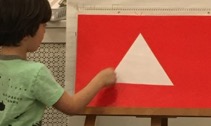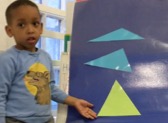“Is It A Pattern?”
Students in the Fours constructed their own rules for what makes a pattern, and then used those rules to create patterns with different attributes of color, size, and direction. The students determined that “With a pattern, you always know what comes next”, and that patterns “Repeat again and again”.
Where’s the Differentiation?
A Size Pattern Was Posed As An Open Problem
Students created their own patterns independently, and then tested their pattern against the rules. Does my pattern repeat? Do I know what comes next? This open problem resulted in a range of work that served as a formative assessment for how well children understood the concept of patterns. This approach was also a useful way to differentiate the needs of the math learners in the class. Teachers could observe students as they worked, and support or challenge them by asking targeted questions based on the individual patterns the children were creating.
Thinking of Numbers to Represent a Size Pattern:
“Two big squares, two medium squares, two big, two medium…”
(Click picture to view video)
Thinking of Letters to Represent a Size Pattern
“B, B, A… B, B, A… B, B, A…”
(Click picture to view video)









